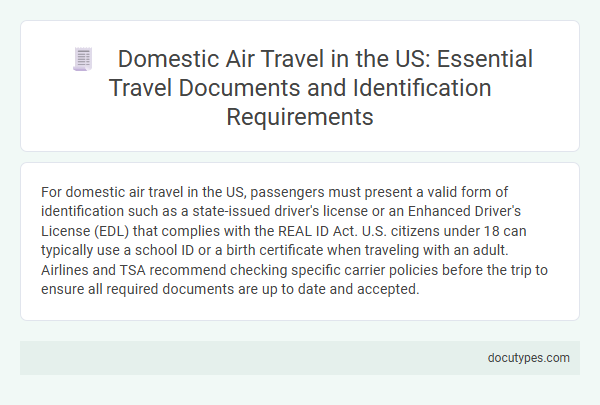For domestic air travel in the US, passengers must present a valid form of identification such as a state-issued driver's license or an Enhanced Driver's License (EDL) that complies with the REAL ID Act. U.S. citizens under 18 can typically use a school ID or a birth certificate when traveling with an adult. Airlines and TSA recommend checking specific carrier policies before the trip to ensure all required documents are up to date and accepted.
Overview of Domestic Air Travel Document Requirements
Domestic air travel in the United States requires passengers to present valid identification at airport security checkpoints. The Transportation Security Administration (TSA) accepts government-issued photo IDs such as a driver's license or state ID card. Passengers under 18 years old may not need identification when traveling with a companion who has valid ID.
Accepted Forms of Identification for U.S. Travelers
For domestic air travel within the United States, the Transportation Security Administration (TSA) requires passengers 18 years and older to present valid identification at security checkpoints. Accepted forms of ID include a U.S. passport, state-issued driver's license, or other TSA-approved identification.
Since May 7, 2025, travelers must carry a REAL ID-compliant driver's license or an acceptable alternative to board domestic flights. Other acceptable documents include a U.S. passport card, military ID, or DHS trusted traveler cards such as Global Entry or NEXUS.
Understanding REAL ID Compliance for Domestic Flights
| Travel Documents Required for Domestic Air Travel in the US | |
|---|---|
| Primary Identification | A valid government-issued photo ID is necessary. Common forms include a state-issued driver's license, a U.S. passport, or a military ID. The ID must be compliant with REAL ID standards starting May 7, 2025. |
| REAL ID Compliance | REAL ID is a federal requirement ensuring enhanced security for state-issued identification. Licenses or identification cards must have a STAR marking at the top to indicate compliance. Only REAL ID-compliant IDs will be accepted for boarding domestic flights without alternative documentation. |
| Alternative Documents | If your ID is not REAL ID-compliant, acceptable alternatives include a valid U.S. passport, passport card, DHS trusted traveler cards, or state-issued Enhanced Driver's Licenses. |
| Check Your ID | Confirm the REAL ID status of your identification before your trip. Airports will enforce these rules, and non-compliance may result in denied boarding. |
Identification Rules for Minors and Children
Domestic air travel in the US requires specific identification for all passengers, including minors and children. Understanding the identification rules helps ensure a smooth boarding process without delays or complications.
- Children under 18 typically do not require ID - TSA does not require identification for minors under 18 when traveling with a companion within the US.
- Proof of age may be needed for unaccompanied minors - Airlines might request documentation such as a birth certificate or school ID when minors travel alone.
- Parents or guardians should carry valid ID - To verify accompaniment, adults traveling with children must present government-issued identification.
Traveling Without a Government-Issued ID
What travel documents are required for domestic air travel in the US when traveling without a government-issued ID? The Transportation Security Administration (TSA) allows travelers to undergo identity verification through an alternative process if they do not have a government-issued ID. Passengers need to provide additional information and may undergo extra screening to confirm their identity before boarding.
Special Considerations for Non-U.S. Citizens
Non-U.S. citizens flying domestically within the United States must carry valid travel identification. Acceptable documents include a foreign passport or a permanent resident card (Green Card).
Some travelers may require additional documentation, such as a visa with valid U.S. entry stamps. Non-U.S. citizens should also present any relevant immigration documents at airport security checkpoints. Airlines may impose their own requirements, so verifying with the carrier before travel is essential.
Tips for Stress-Free Airport Security Checks
For domestic air travel in the US, a valid government-issued photo ID such as a driver's license or a state ID card is required. The Real ID Act enforcement means your ID must be compliant for airport security checkpoints starting from the designated enforcement date.
You should arrive early to allow enough time for security screening and have your ID and boarding pass ready for inspection. Wear easily removable shoes and avoid carrying prohibited items to speed up the TSA security process.
What to Do If You Lose Your ID Before Your Flight
Traveling within the United States by air requires specific identification documents for security and boarding. Understanding what to do if you lose your ID before your flight can help avoid last-minute stress and ensure smooth travel.
- Valid Identification Required - Passengers must present a government-issued photo ID, such as a driver's license or passport, at TSA security checkpoints for domestic flights.
- Report Lost ID Immediately - Inform airline staff and TSA officers as soon as you realize your ID is missing to receive guidance on alternative verification procedures.
- Use TSA's Identity Verification Process - TSA allows travelers without ID to undergo additional screening and identity verification through personal questions and documentation before allowing boarding.
Preparing by carrying backup documents and arriving early increases the chances of resolving lost ID issues smoothly before your flight.
Frequently Asked Questions About Domestic Air Travel Documents
For domestic air travel in the US, a valid government-issued photo ID is typically required, such as a driver's license or a state ID card. Travelers 18 and older must present an acceptable form of identification at airport security checkpoints. Your boarding pass and identification will be checked before boarding the aircraft.
What Travel Documents Are Required for Domestic Air Travel in the US? Infographic

